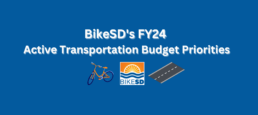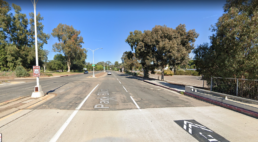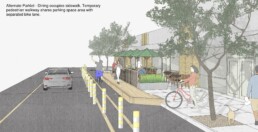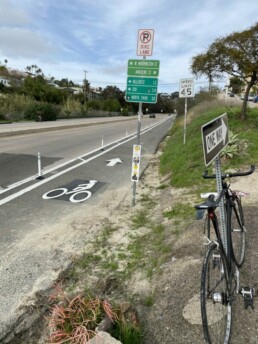Action Item: Send a Letter to ask the City of San Diego to include Active Transportation Priorities in Final FY24 Budget
Action Item: Send a Letter to ask the City of San Diego to include Active Transportation Priorities in Final FY24 Budget
The final budget for the Fiscal Year 2024 is approaching, and BikeSD is organizing a campaign to ask the City of San Diego to allocate money to both general and district-specific projects that will improve the safety of active transportation users in San Diego.
Many of the asks included below are ones that councilmembers have asked for in their budget memos already.
The first version of the final budget will be released on April 14th. Other important upcoming dates are below:
-
- April 14th – First version of Mayor’s FY2024 budget released
- May 3rd – First public input budget hearing (opportunity to call in and provide support for specific projects and budget allocations)
- May 10th – Second public input budget hearing (opportunity to call in and provide support for specific projects and budget allocations)
- May 16th – Revised draft of Mayor’s FY2024 budget released
Show your support for these budget priorities by writing your own personal message to MayorToddGloria@sandiego.gov, and RWilde@sandiego.gov and please BCC: campaigns@bikesd.org. Modify this sample letter and copy/paste to your personal email app:
Honorable Mayor Gloria,
With the Fiscal Year 2024 final budget quickly approaching, we would like to request that several items from Council District budget priority memos be included in this budget. These priorities were chosen by members of the community for the ways they will improve active transportation safety for users, increase ridership, and meet Climate Action Plan goals.
Vital priorities that are highlighted across multiple councilmembers’ memos include the need for maintenance of our existing bikeways and greater physical protection for future class IV bikeways.
Increase Bikeway Maintenance ($150,000):
Potholes, poor pavement, and road debris pose a much greater threat to bicyclists than drivers. These hazards can seriously injure or kill bicyclists, while posing minimal risks to drivers. Transportation should dedicate a specific team of three staff members or contractors to conduct routine bikeway maintenance and respond to requests for service on bikeways. These staff members could be reassigned from existing staff, hired as contractors, or hired as new employees, depending on the city’s needs.
Install Physical Protection for All New Full-build Class IV Bikeways ($300,000 – $1.2 Million):
Almost all recent Class IV bikeway projects in San Diego have used flexible bollards to separate bikeways from travel lanes. While flexible bollards are useful for demarcating space for bicyclists, they do not have any stopping power to prevent drivers from hitting bicyclists. All new full-build Class IV bikeways should use physical protection such as concrete curbs or inflexible bollards to separate bikeways from traffic lanes. This item would require increasing the Transportation Department’s budget for each new Class IV bikeway.
As the city currently spends approximately $200,000 per mile when implementing Class IV bikeways during resurfacing, this budget request would require $50,000 to $200,000 in additional funding per mile, depending on the type of physical protection implemented. The funding needed for this request would depend on the miles of Class IV bikeway planned for FY 2024. Based on the 5.6 miles of Class IV bikeway that Transportation has planned for FY 2023, total cost would be approximately $300,000 – $1.2 Million.
Along with these items, we ask that you also strongly consider the following district specific items that were mentioned in the budget memo.
District 1
Complete Pacific Beach Pathways Phase 3
Including the connection at Olney Street to the Campland entrance, the Cass Street component between Tourmaline Street and Pacific Beach Drive, and connection at Diamond, Fanuel and Reed Streets.
District 2
Construction of Morena Blvd Class IV Bikeways
The Transportation Department is scheduled to construct bikeways on Morena Boulevard in conjunction with a pipeline replacement within the next several years. This is the most direct connection between neighborhoods South of Interstate 8 and the Pacific Beach, La Jolla, and University City communities, and as such, is an extremely popular route for cyclists despite the total lack of safe bicycle facilities. I urge the city to expedite this project as much as possible, as it has already been approved for Class IV cycle tracks within the Balboa Station Area Specific Plan and the Morena Corridor Specific Plan.
District 3
Complete Remaining Segments of Downtown Mobility Plan Bikeway Network
Six years after the completion of San Diego’s 2016 Downtown Mobility Plan, significant sections of the proposed bikeway network remain incomplete. To unlock the enormous bicycle transportation potential of Downtown San Diego, the city should expedite the remaining uncompleted bike network segments, including Grape Street, Hawthorne Street, State Street, Park Boulevard, C Street, (between 6th Ave and Park Blvd), and Broadway. Filling these remaining gaps in the Downtown network would fulfill the vision of the Downtown Mobility Plan and allow cyclists to access most major destinations in Downtown San Diego in a separated bikeway facility.
Camino Del Rio South, from Mission Center Rd. to Montezuma Rd Bikes Facilities
This is a key connection that cyclists traveling through Mission Valley use to connect to neighborhoods South of Interstate 8. Crucially, it is the only Mission Valley access point to the SR-15 Commuter Bikeway, which is currently the only fully separated bike path connecting Mission Valley and Normal/City Heights. It is also a very dangerous road; on September 14, 2021, Matt Keenan was killed on this stretch of road while riding his bike. The city should consider implementing a Class IV bikeway or rapidly developing an alternative East/West route through Mission Valley.
District 4
Euclid Ave/54th St. Complete Streets Improvements, from East Division St. to 54th St.
National City recently installed a buffered and parking-protected bike lane on the section of Euclid Avenue within its city limits. The City should continue this separated bikeway on the remainder of Euclid Avenue and its continuation onto 54th Street to provide a safe and continuous bike facility along the full length of this corridor.
District 5
Add physical protection to Camino del Norte
This 50 mile per hour road stretches three lanes across on each side, and currently only a line of paint separates bicycle users from this fast-moving traffic. Schools, residences, restaurants, and places of employment are connected by this road, and bike users would benefit greatly from the physical protection that class IV lanes would provide.
District 6
Nobel Drive
Nobel Drive serves as the major thoroughfare that cuts through University City. From west to east, it is lined by shops, homes, hotels, parks, and businesses. In the future, class IV protected bike lanes can connect to a protected bikeway on Genesee Avenue, providing a safe and comfortable path between University City and Clairemont. There are already plans to add protected bike lanes on Nobel Drive between Lebon and Genesee – this would complete the corridor throughout.
District 7
Build ten miles of critically needed safe bikeways during resurfacing, based on collision history and where potential ridership is the largest, including along Mission Gorge Rd, between Friars Rd and Alvarado Canyon Road.
District 8
Palm Avenue Revitalization Plan
The Palm Avenue Revitalization Plan includes strategies to promote economic development and improve vehicle, transit, pedestrian, and bicycle mobility along Palm Avenue between 13th Street and Hollister Street.
District 9
Add Physical Protection on Montezuma Road Bike Lanes, from the Fairmount Bike
Path to College Avenue
This is a key connection from the popular Fairmount Bike Path to SDSU that is used by many students. Particularly in the uphill (Eastbound) direction, physical protection should be added to separate the bike lane from the traffic lanes, where vehicular speeds regularly reach up to 60 mph.
We thank you for your commitment to active transportation, and for demonstrating your commitment to supporting safe streets and sustainable communities by allocating City resources to these projects.
Sincerely,
_____________
Action Item: Send a Letter to ask the City of San Diego to Implement a Protected Bicycle Facility along Park Blvd in Balboa Park

Action Item: Send a Letter to ask the City of San Diego to Complete the Corridor; Implement a Protected Bicycle Facility along Park Blvd in Balboa Park
UPDATE, JANUARY 30, 2023: In early September, after months of extensive outreach, the City announced plans for protected bike lanes and separated bus lanes throughout most of Park Boulevard within Balboa Park. This is a massive win for active transportation within the City’s Crown Jewel; thank you so much to everyone who called into the planning meetings to voice your support for bikes and buses within the park! These lanes should be completed in early 2023. If you have additional questions, please contact us at talk@bikesd.org, and consider the Action Item below completed.
Since June 2021, BikeSD has been discussing with the city the opportunity to have a fully protected Class IV bicycle facility along the entire Park Boulevard corridor.
In Downtown, the city has recently implemented part of the Park Blvd section of the Downtown Mobility Plan, with the remaining segments of the class IV cycletrack already planned from K St to the I-5 bridge. From Village Place to Robinson Ave, SANDAG’s Uptown Segment 5: Park Blvd Bikeway is in the pipeline to provide improvements. And just last week, KPBS spoke with BikeSD board member Ari Criste to report on the city’s new plans to implement protected bike lanes on Park Blvd from Adams Ave to University Ave.
The last big stretch in Balboa Park is still up in the air. In November 2021, our campaign got the support of Uptown Planners, who wrote a letter in support of a class IV protected bikeway on Park Blvd in Balboa Park. The city has drafted plans for micromobility improvements to the corridor, but has not yet shared them to any community groups. We need your help to encourage the city to implement a fully-protected facility as part of the upcoming pipeline and street resurfacing project along Park Blvd in Balboa Park.
EVEN BETTER:
Write your own personal message to MayorToddGloria@sandiego.gov, StephenWhitburn@sandiego.gov, and jriveros@sandiego.gov, and please BCC: campaigns@bikesd.org. Modify this sample letter and copy/paste to your personal email app:
Dear Mayor Gloria, Councilmember Whitburn, and Transportation Director Riveros,
Thank you for the planned improvements for Park Blvd between University Ave and Adams Ave. My family and I appreciate using low-stress bike facilities to get around for our daily transportation needs.
In addition to the section of Park Blvd from University Ave to Adams Ave, we ask that the Balboa Park segment of Park Boulevard’s resurfacing efforts include a new Class IV (protected) bikeway. Park Blvd is a critical corridor between Uptown and Downtown – we are currently seeing a large volume of self-reported bicyclists using this path on a regular basis, according to open source heat maps such as Strava and Ride With GPS. Currently, micromobility users are expected to share this 2-lane roadway with parked vehicles and those driving 40+ MPH. Ideally, this road would be reduced to a single general-purpose lane traveling in either direction, a transit lane, and a protected bike facility.
Similar improvements have already been scoped out in the 2012 Bicycle Master Plan, which proposed building out a Class II (i.e. painted bike lanes) bikeway along the entirety of Park Blvd from Upas St to B St. The Balboa Park Master Plan also prescribes a bicycle trail along Park Blvd, and while a Class II bike lane would be a step in the right direction, pivoting to a Class IV protected bike lane would provide safer and more accessible infrastructure for all ages and abilities and align better with NACTO guidelines. Similar to how building more highway lanes induces greater vehicular traffic demand, building safer bicycle infrastructure induces greater bicycle traffic demand.
Besides inducing greater demand for bicyclists, safe bicycle infrastructure reduces carbon emissions within the park, slows down vehicular traffic, and improves pedestrian safety. Encouraging an increase in bicycle trips between significant commercial and residential cores (Uptown, North Park, and Downtown), as well as the numerous educational and cultural institutions along the corridor gets San Diego closer to its Climate Action Plan (CAP) goals of hitting Net Zero emissions by 2035. This upgrade is also in alignment with the 2021 Parks Master Plan which aims, among other things, to provide easy access to parks by walking, biking, and transit. Finally, by reducing speeds and protecting non-vehicle users, these improvements support the city’s Vision Zero goals.
Sincerely,
_____________
The Time is Now
We cannot fear change, we must adapt.
In the swell of pivoting to ensure small businesses survive the ever-changing landscape of pandemic-related restrictions; the City of San Diego temporarily eased restrictions on establishing parklets.
Let’s make temporary permanent. Let the parklets stay.
As San Diegans, we are accustomed to and often prefer opportunities to dine outdoors. With our average 75-degree and sunny weather, San Diego is in the perfect climate position to encourage and support parklets.
This also provides a perfect climate position to encourage and support cycling. The dedicated bike lane on 30th Street is an integral part of the North Park of the future.
Close your eyes and imagine a vibrant, people centric, 30th Street with fewer cars, more people meandering between establishments and more people riding up to their favorite restaurant - imagine 30th Street busy, but with far few car horns.
Since the shutdown a year ago, there are now over 450 businesses leveraging parklet space as business space to serve their customers. It is a wonderful sight to behold and is one many would like to see in San Diego permanently. We love it and believe it is a healthy, vibrant, wonderful future for our business districts.
Unfortunately, there is a conflict on 30th Street between a long anticipated paving project and the parklets we wish to remain in operation. We believe there is a solution for these businesses’ parklets to stay permanently after businesses are opened to indoor dining. Timing is everything. If we do not act swiftly, we will lose the majority of the parklets that we have learned to love and enjoy.
Among the parklet designs available from the City San Diego, BikeSD is advocating for an option that is a win for everyone. We spoke with several North Park business owners regarding this particular parklet design and received a majority of enthusiastic and optimistic responses. There was also an overwhelmingly positive response to the upcoming bike lane, too.
This alternative design moves the parklet to the sidewalk while providing a safe ADA walkway in the street right of way. This eliminates people walking through business patrons and allows for a continuous business. No wait staff weaving through tables and pedestrians. It creates a cohesive environment where customers can hear the music, see the televisions and feel like part of the venue while enjoying the outdoors. Lastly, but critically, it provides the space for a continuous bikeway that avoids conflict zones. This is a solution that can support businesses to continue outdoor dining past the pandemic and into a more vibrant people centric city.
We want to continue supporting our North Park businesses. Join us and ask city staff and Mayor Gloria to work on a solution for all, quickly and efficiently as we support the upcoming resurfacing project and want businesses to adapt and be prepared for the spring and summer season.
Let’s act quickly and efficiently so we can support the upcoming resurfacing project, allow businesses to retain their parklets and be prepared for the spring and summer season.
Let’s be bold. Let’s take this opportunity to construct 30th Street for all of North Park, to be a leader for the rest of San Diego.
Who is ready for bike parties on a parklet filled 30th Street? We are ready.
Mobility Board Votes to Support Gilman Drive Segment of Coastal Rail Trail
The City of San Diego Mobility Board voted to approve the Gilman Drive Segment of the Coastal Rail Trail. The Coastal Rail Trail will connect Oceanside to Downtown San Diego, and the Gilman Drive section will more immediately connect UC San Diego to the almost completed Rose Creek Bike Path (which is being built by SANDAG as part of the Early Action program). The project will be implemented as a protected cycletrack (class IV) on both sides of the road from the I-5 interchange to La Jolla Village Drive. A dedicated bike traffic light and signal phase will also be added southbound at the entrance to I-5. Additionally, the gaps in the sidewalk on the west side of Gilman Drive will be filled in and a sidewalk will be added underneath the interchange with La Jolla Village Drive (where many students who live nearby have already created desire paths and are forced to play frogger with cars).
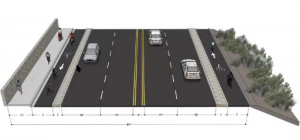
BikeSD is glad to see a protected cycletrack implemented. Not only is the current unprotected bike lane very narrow immediately north of the I-5 freeway interchange, it is made narrower by overgrown shrubbery from the canyon to the east. Combined with the curvature of the road as well as a 50mph speed limit, Gilman Drive as-is is a collision in the making. According to data from the Statewide Integrated Traffic Records System (SWITRS), there have been 15 reported bike rider collisions along the portion of Gilman Drive that will be renovated, from 2009 to 2019. Of course, many collisions also go unreported.
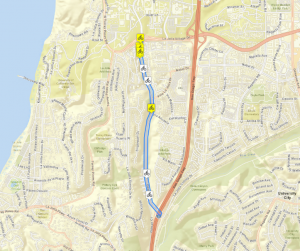
That being said, BikeSD has some reservations about the project. The project's estimated cost, $22 milion, is astronomical, and is due to the insistence of maintaining 12 foot travel lanes & a 50mph speed limit and adjacent street parking, as well as building retaining walls and working with sensitive lands. A much more affordable tactical project could have been completed with a road diet, particularly considering the lack of congestion on Gilman Drive, little parking demand south of Via Alicante, and the opening of the Mid-Coast Trolley Extension of the MTS Blue Line, which will reduce road demand even further.
Despite our reservations, this will be an important connection that will encourage even more San Diegans who are "interested but concerned" about biking to ditch their cars and help San Diego reach its Climate Action Plan goals of getting 18% of commuters to go by bike. While the project is still only partially funded, construction is anticipated to begin in Fall 2021. You can see the Mobility Board's discussion of this agenda item and the presentation by city staff via this link: Youtube
EDIT: A previous version of this article reported 11 bike rider involved collisions along the relevant section of Gilman Drive.That has been corrected to 15. The generated report can be found here.
See what its like to ride the notorious Washington Street uphill
BikeSD Advocates Ride Washington Street, not for fun
After a 65 year old cyclist was killed in a hit and run accident, BikeSD has been working to address Uptown bicycle route safety and get a previously deleted bike lane restored. In the first few seconds of this video its easy to see how the dangerous design of this roadway resulted in death. Our team had a few close calls themselves.
The current Class III painted “sharrows” in the second eastbound travel lane are not recommended by the State of California for speed limits above 35 MPH. However the posted speed limit is 45 MPH, and in the video cars can be seen travelling 55 MPH or more, with some motorists even exceeding 70 MPH. Forcing bicyclists into dangerous, high-speed traffic on a steep incline like this is a recipe for disaster. The City is also not notifying motorists that the road contains a bike lane, as the signage that was posted on the hillside has been removed, and the street cycling symbol on the road has been painted over. Along with being a designated ‘Bike Route’, Washington Street is the main connector to the Washington Street Trolley Station for residents of Mission Hills, Hillcrest and Bankers Hill.
We sent a letter to the Mayor asking the city to immediately address public safety hazards on the Uptown bicycle route at eastbound Washington Street and return the Class II bicycle facility on the south side of the road. We will continue to ask that the City prioritize residents’ lives and well-being over a dozen free parking spaces.
Help us restore the Washington Street bike lane until the completion of the SANDAG Washington Street Bikeway in this area. Contact your councilmember or the mayor’s office and tell them to restore the bike lane on Washington Street.

